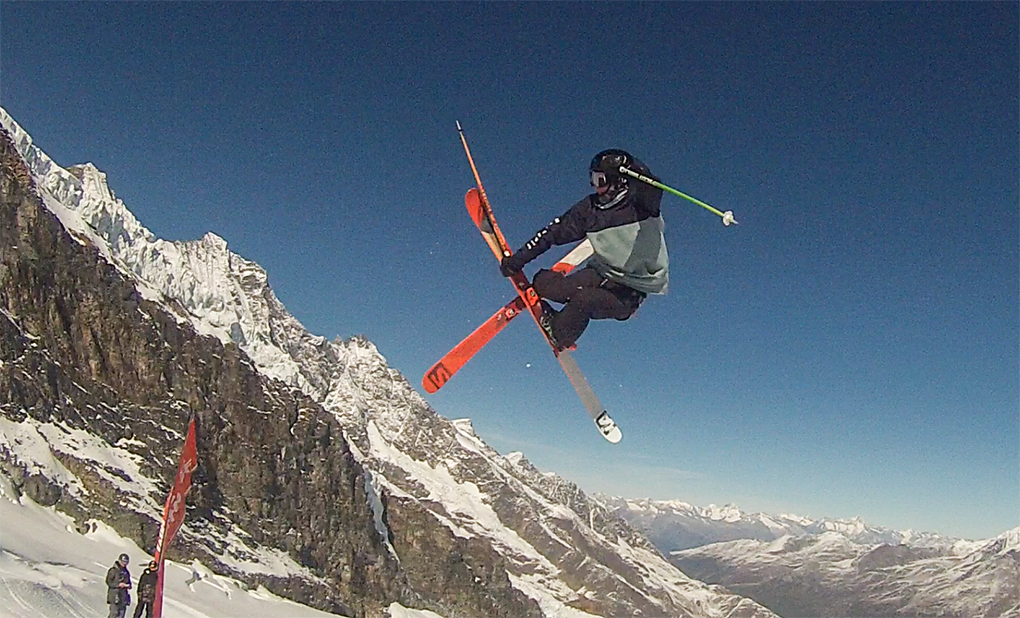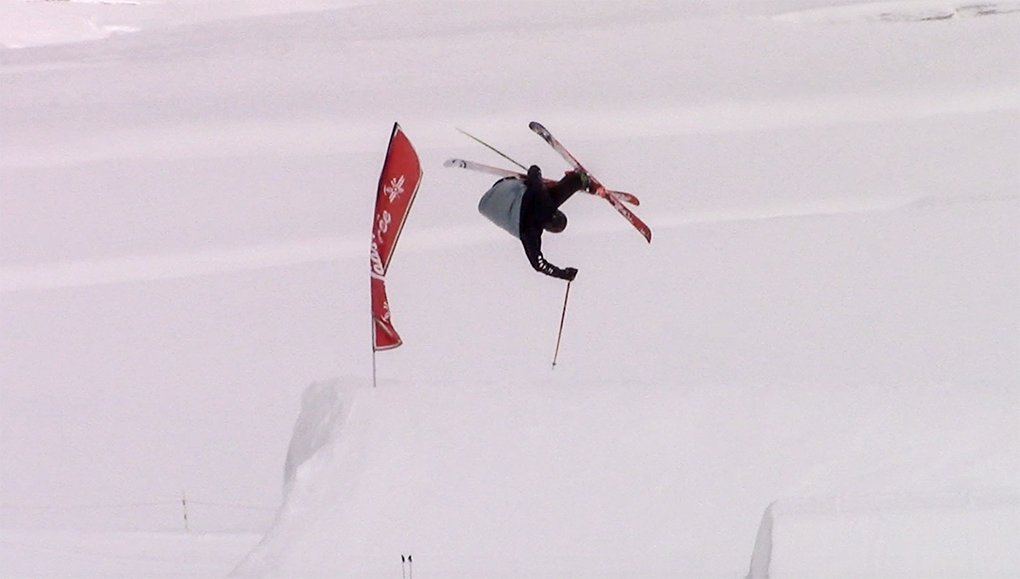
Ski: 2019-2020 Salomon NFX, 182 cm
Available Lengths: 160, 170, 176, 182
Actual Tip-to-Tail Length (straight tape pull): 179.7 cm
Stated Dimensions (mm): 122-86-115
Stated Weight per Ski: 1840 g (176 cm)
Stated Sidecut Radius (181 cm length): 18.6 meters
Core Construction: Poplar + Elastomer Pad Underfoot + Fiberglass Laminate
Mount Location: -1cm from true center
Boots / Bindings: Dalbello Il Moro T ID / Rossignol FKS 140
Days Tested: 6
Test Location: Saas-Fee, Switzerland
[Note: Our review was conducted on the 15/16 NFX, which was not changed for 16/17, 17/18, 18/19, or 19/20, apart from graphics]
Intro
I went to Saas Fee, Switzerland, with two skis to review: the 181cm Head Caddy and the Salomon NFX. I was initially interested in these skis because they both arguably stand as the flagships of each brand’s sort of comeback, if you will.
Salomon and Head both, at separate points, helped revolutionize “new school” skiing. With the X-Scream 1080, Salomon produced the first modern twin tip and absolutely dominated the freeskiing market for both hard goods and soft goods between 2006 and 2010. Head then created the Mad Trix a few years later, and it was on the Mad Trix that Jonny Moseley broke out the Dinner Roll, and Jon Olsson started the sport’s double-cork frenzy.
Since those days, other companies have pushed their way into the spot light. With Simon Dumont as the new face of the brand, Head released the Caddy a couple of years ago as its big push to get Head back on top. And Salomon answered back with the NFX.
The Caddy and the NFX have both seen their share of podiums in the past two seasons, and they’re both billed as competition-ready park skis. But each company has taken a drastically different approach. I skied the Caddy in the week leading up to my time on the NFX, and I immediately noticed just how radically different they are.
The NFX, which appropriately stands for “No Fucking Excuses,” is as uncompromising as comp skis come. A quick hand-flex reveals that the NFX is incredibly stiff. It’s also one of the heaviest park skis I’ve ever ridden. Before getting on the NFX, a trusted friend of mine told me, “The NFX makes the Fischer Nightstick look playful.”

So going into this NFX review, I was primarily interested in two questions: (1) Is the NFX truly the ultimate competition slopestyle ski? And (2) if so, has this come at the expense of every other aspect of its performance?
Jumps
The NFX is, bar-none, the most stable park ski I have ever ridden.
Without question, it surpasses the Fischer Nightstick, which I had previously held as the gold standard in this category. The NFX combines a burly sidewall construction with lots of camber, and the end result is a highly stable and damp park ski that contains lots of helpful recoil to get your skis quickly back on the ground on landings. You’re not wheelie-ing out on the NFX.
It’s very clear that when jumping on the NFX, the ski gives you no fucking excuses for why you didn’t land your trick or contest run. If I landed a bit back seat on either of Saas Fee’s large jumps, the NFX made fighting for landings that much easier. If I landed switch too far up on my tips, the NFX would never flex out and cause me to wash out. The stiff tips and tails would hold strong and not let my body weight continue to fall forward, but would instead immediately get all of each ski’s base material back to the snow as quickly as possible.
Put simply, when I crashed on the NFX, it was only when I wasn’t even close to landing, and it was very obviously my fault that I crashed.
So, supreme stability? Check.
But the NFX’s unwillingness to compromise any of that stability does come with a few consequences.
First, it’s a very heavy ski. Compared to the Head Caddy, it was noticeably more difficult to initiate tricks at first. I even grew a bit frustrated with the NFX the first day I skied it—I was having trouble initiating switch tricks because I felt less agile and couldn’t hit good takeoffs on the NFX. But the adjustment period was fairly short, and I grew accustomed to the NFX’s additional weight. Part of what made the transition feel extreme was the fact that I skied an exceptionally light ski one day (the Head Caddy) and then skied the NFX, a ski on the heavier end of the spectrum, the very next day.

By my third day on the NFX, I didn’t really notice the additional weight at all. Suffice it to say, the weight isn’t insurmountable, and after skiing the NFX for six days, I can say that the NFX’s additional weight is a small price to pay for such an uncompromisingly stable ski.
And let’s provide a bit more context: it becomes apparent pretty quickly that—and why—the NFX is Bobby Brown’s pro-model ski. At 6’2” and 185 lbs, Bobby’s a pretty big guy as far as freeskiers go. Being 5 inches taller and 35 pounds bigger than me, it makes sense why he might prefer a really stiff, beefy ski as his go-to slopestyle ski at contests. Because I’m a good bit lighter than him, the NFX is more difficult to load up and initiate tricks. But I’m willing to wager that a larger person is able to reap all of the benefits of this stable ski while still being able to maneuver it easily and get it to do everything that a park ski should.
So if you’re a bit smaller and looking for a stable park ski that doesn’t feel like too much ski, the Fischer Nightstick might be the better option. Its stability still comes at the expense of some of its playfulness, but it will feel a bit more manageable for a smaller person.
NEXT: Rails and Jibs, Etc.

Hi
Great review, have you also skied the Rossi Slat ? How do the Caddy and NFX compare to the Slat ?
thks
Ian,
I’ve only skied the Slat for literally one park run, but I’ll try to make comparisons.
As far as flex patterns go, the Slat falls somewhere between the Caddy and NFX; fairly stiff, but a noticeable touch softer than the NFX. It also features a bit of tip and tail rocker, which more aligns itself with the Caddy, but the rocker being a bit more noticeable than the Caddy. It’s also generally heavier than the Caddy and slightly less playful, despite its wider waist and more aggressive rocker profile. Additionally, the Slat is considerably wider underfoot than either ski at 97mm wide. The Slat isn’t quite as stable as the NFX, certainly, and it lends itself a somewhat clunkier feel than the Head Caddy.
Sorry I can’t make more conclusive statements than that, as I really haven’t put much time on the Slat.
Scott
Hi Scott! Great review! Just got a set of NFXs myself. I wonder if you have any input of mounting position?
Usually mount true center on park skis, even though I tend to use them in pist quite a lot as well.
How did you feel about going back 1 cm?
Hi Scott, thanks for the review of the NFX. Can you also campare the NFX with the Nordica ace of spades?
Thanks
Hey Scott,
Do you think the NFX ski’s the slopes well?
thankyou